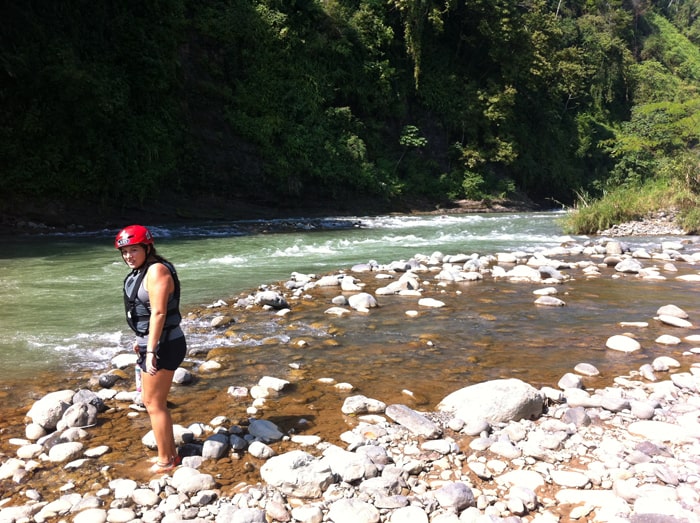RÍO NEGRO, Guanacaste – There is no drifting, no time for anything pensive, no beer cooler floating beside you, nothing that resembles relaxation and you can forget about keeping your cigars dry. This is whitewater tubing. Here, the water churns like mango pulp in a blender on puree, and the rubber donut tubes are dunked in a froth at the bottom of each little waterfall. Rocks nip at your hiney and you have to push away from them if you have a leg turned that way, or a shoulder, and the rubbery cushion underneath does not soften all the blows.
But it’s a family activity – a seven-year-old has done it. It’s an intimate experience with the river. Unlike rafting, where people are separated from the water by at least two feet of compressed air and the paddle is always a buffer, tubing gives you a water bug’s view of the torrent. There is no guide in the tube with you – the tubers control the entire show.
The foam plops right in your lap, nothing is dry and you can’t stop screaming when you plunge over steep, class three and four rapids and lose your tube at the bottom. “Whitewater rafting is more about teamwork,” said one tuber, Eugenia Chaves, who went with her husband and 11-year-old son. “The fact that you don’t have to worry about the rest of the team – (tubing) is a more personal experience.”
THE sport takes place on the Río Negro where it tears through a forest near the volcano Rincón de la Vieja, north of Liberia. The Hotel Hacienda Guachipelín hosts the trip and provides the guides. The river is narrow and shallow throughout the course, not too deep for people to stand up in many places, making this raging trickle too small for rafts and just right for tubes.
The tubers carouse the rapids in trendy yellow helmets and life vests. Here, safety is handled almost to a fault. A small army of guides outfitted with harnesses, carabineers, nylon straps and spare tubes if one pops, herd people away from the tight fits between rocks or the shores, rescue people from the eddies and bury the drowned. (Just kidding.)
They are in the water, sometimes anchored with the nylon lines, to nudge tubes around boulders or to push them along through the doldrums. The tour is registered with the Costa Rican Tourism Institute and the guides are trained in first-aid. Sticklers for safety, the measures are so extensive they are almost overkill, sometimes causing delays in larger groups while people wait at the bottom of a low fall for everyone to slip down and float to calmer water. It’s only a problem if you’re impatient. But the extra push in the calm water brings on the waterfalls more quickly.
THE idea for the ride sprang from the genius of José Tomás Batalla, one of the owners of Guachipelín, when his sister told him about tubing tours on meandering rivers in the southwestern United States. There was no calm stretch of river through his family’s land, so he dropped some tubes in the Río Negro and banged around the rapids. After working out most of the kinks, including scaring off the illegal loggers who cut branches that littered the water, and rounding up good guides, he opened the ride to the public in January.
“The idea is to give a high adrenaline tour to people in Guanacaste. It’s not for everybody, it’s for people who like adventure,” he said. In a nod to the copycat canopy tours around the country and the legal battles they spawned, he said, “Lots of people will follow in our footsteps, but we’re not going to patent this.”
It begins and ends with a half-hour horseback ride from the grounds of the hacienda along a forest path – people also walk or take a truck. DON’T do it “if you’re scared of certain things or if you’re not physically fit.” Chaves said. So, though it’s not for everyone, she said “it was up to a lot of people’s expectations.”







